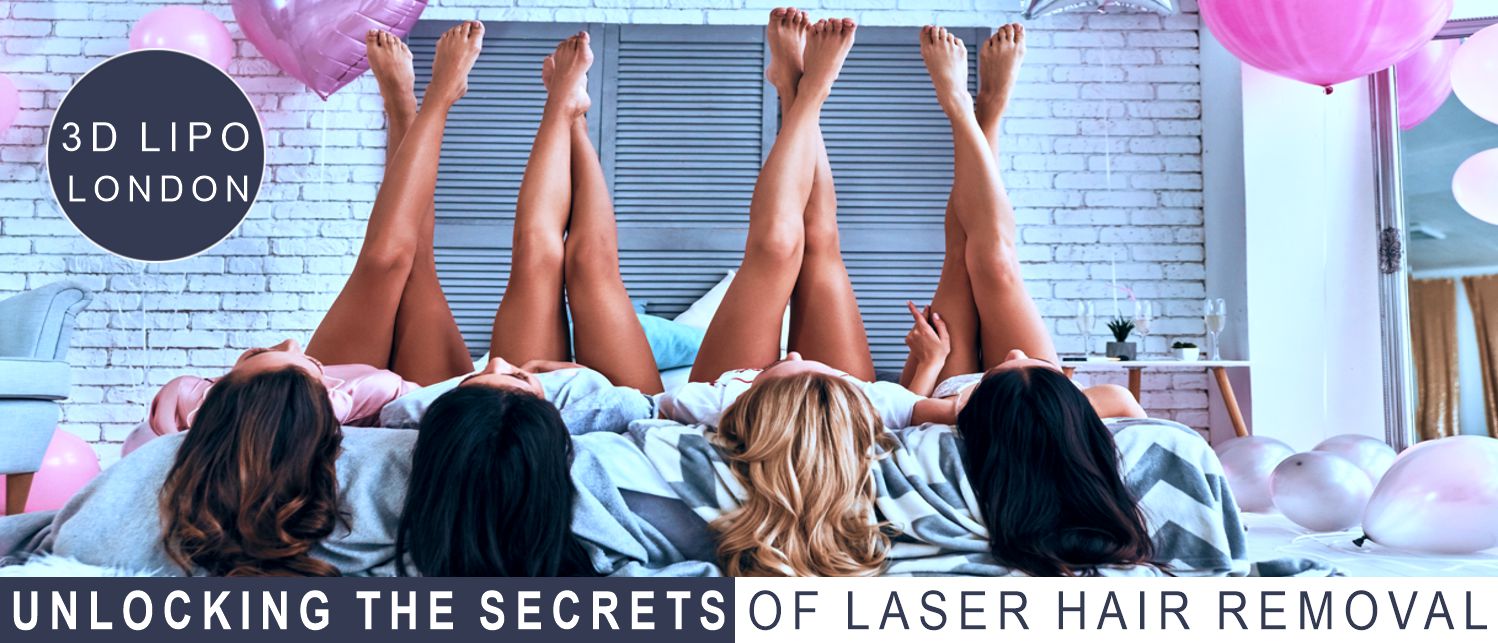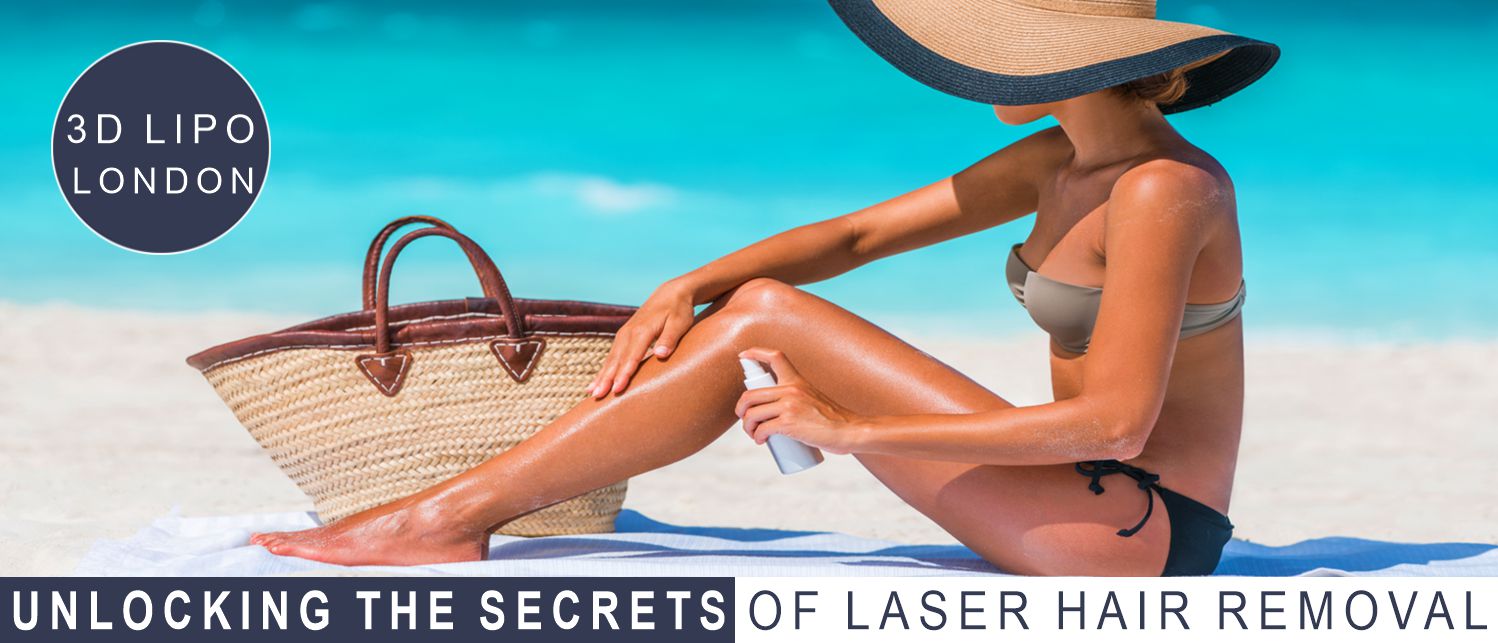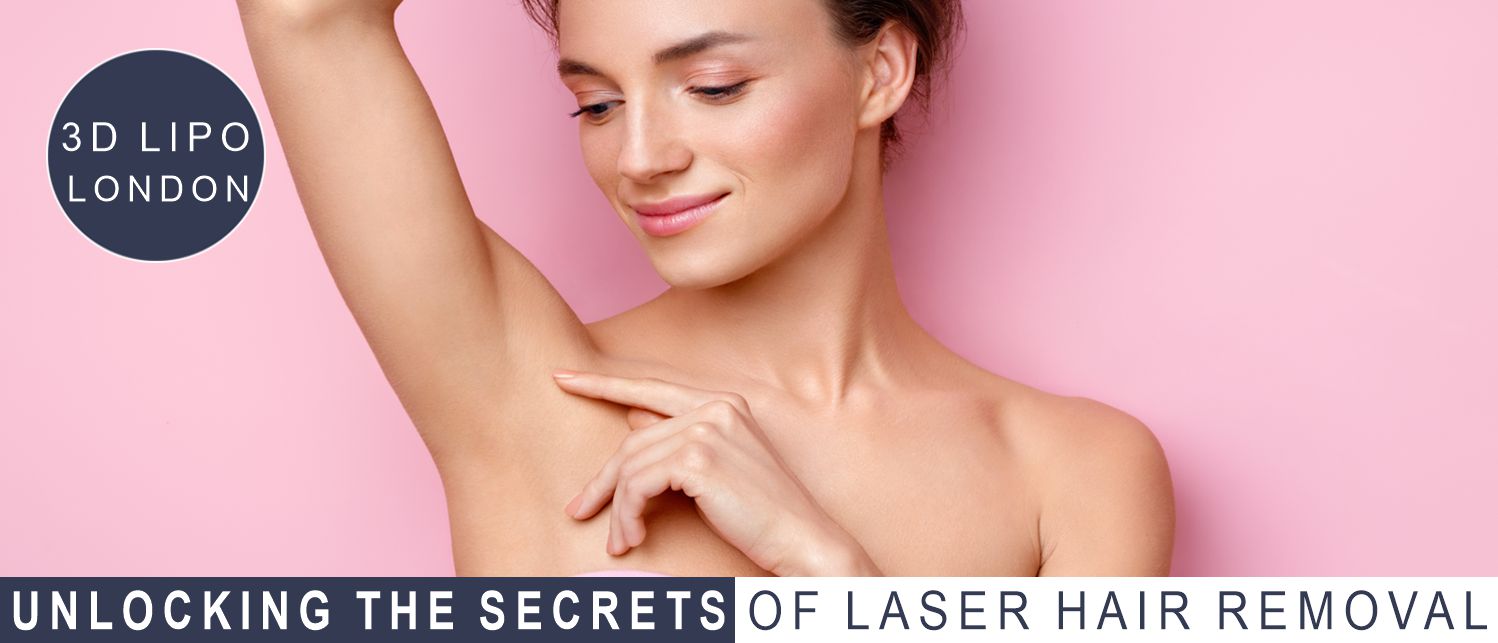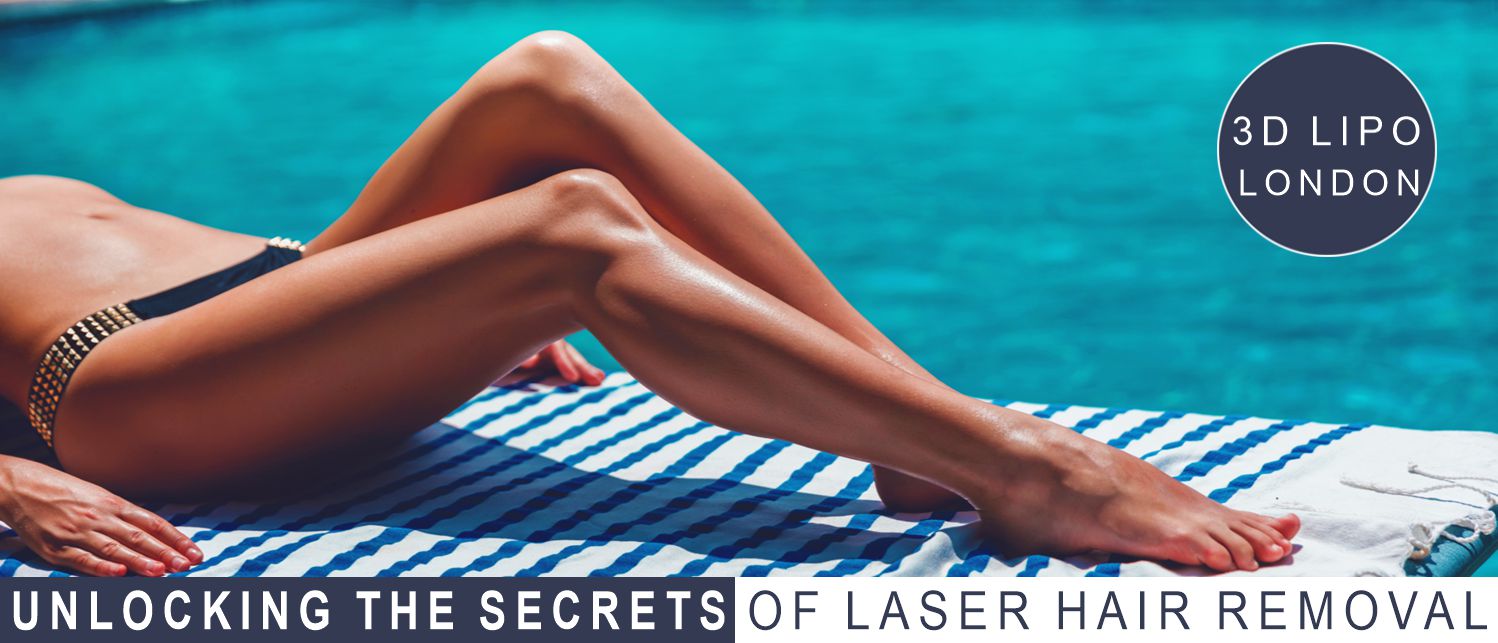3D LIPO LONDON

Unlocking the Secrets of Laser Hair Removal: Everything You Absolutely Need to Know
24th August 2024
Laser hair removal has become the go-to solution for individuals seeking a long-lasting solution to unwanted hair. Whether you're tired of the repetitive process of shaving or the discomfort of waxing, laser hair removal offers a promising alternative. However, before you dive into this popular cosmetic treatment, it's crucial to understand its complexities. From why it might not be effective for everyone to knowing which areas of your body to avoid, this guide covers everything you need to know to make an informed decision.
The Science Behind Laser Hair Removal
At the core of laser hair removal lies a principle known as selective photothermolysis. This somewhat technical term describes how laser light is used to target and destroy hair follicles. Here’s how it works: the laser emits a concentrated beam of light that is absorbed by the melanin (pigment) in the hair. This light energy is then converted into heat, which damages the hair follicle, effectively inhibiting future hair growth.
The effectiveness of this process heavily depends on the contrast between your skin tone and hair color. The ideal candidate for laser hair removal has light skin and dark hair because the laser can easily distinguish between the pigment in the skin and the pigment in the hair. The greater the contrast, the more efficient the treatment.
Understanding the Different Types of Lasers
Not all lasers are created equal, and the type of laser used during your treatment will largely depend on your skin tone. Different lasers have varying wavelengths and are designed to treat specific skin types and hair colors. Let’s break down the most commonly used lasers:
-
Alexandrite Laser: Often referred to as the golden standard for individuals with light to olive skin tones, the Alexandrite laser operates at a wavelength of 755 nm. It’s incredibly effective for targeting dark hair on lighter skin, offering a quick and efficient treatment process.
- Nd Laser: This laser is specifically designed to treat darker skin tones. Operating at a wavelength of 1064 nm, the Nd laser penetrates deeper into the skin, bypassing the melanin in the epidermis and focusing directly on the hair follicle. This reduces the risk of skin damage, making it a safer option for individuals with more melanin-rich skin.
-
Diode Laser: Known as the versatile all-rounder, the Diode laser can treat a broad range of skin tones, from light to medium-dark. With wavelengths ranging from 800 nm to 810 nm, it provides a balance between efficacy and safety, making it suitable for most skin types.

Why Laser Hair Removal Might Not Work for Everyone
Laser hair removal is undoubtedly a game-changer for many, but it’s not without its limitations. One of the biggest factors that determine the success of the treatment is the color of your hair. Unfortunately, if you have blonde, red, or grey hair, laser hair removal may not be as effective for you.
The Challenge with Blonde and Red Hair
The primary reason laser hair removal struggles with lighter hair colors is the lack of melanin. Since the laser relies on melanin to target and destroy the hair follicle, individuals with blonde or red hair have less pigment for the laser to focus on. Here’s a closer look:
-
Blonde Hair: Blonde hair contains less melanin, making it difficult for the laser to differentiate the hair from the surrounding skin. This means that the laser may not generate enough heat to damage the follicle, leading to less effective results.
-
Red Hair: Red hair contains a different type of pigment called pheomelanin, which is less responsive to the wavelengths used in laser hair removal. This makes it harder for the laser to target and destroy the hair follicle effectively.
For those with light or red hair, alternative hair removal methods might be more suitable, as the results with laser treatments could be disappointing.
Tattooed Skin: A Word of Caution
If you have tattoos, it's essential to approach laser hair removal with caution, especially in areas where you have ink. The laser used for hair removal doesn’t just target hair pigment; it also reacts to the pigment in tattoos. This can lead to unintended consequences.
Potential Risks Include:
-
Burns and Scars: When the laser comes into contact with tattooed skin, the concentrated light can cause burns or even permanent scarring. This is because the laser cannot distinguish between the pigment in your hair and the pigment in your tattoo.
-
Tattoo Fading: The laser can also cause your tattoo to fade or become distorted. This happens because the laser breaks down the pigment in the tattoo just as it would with hair, leading to a loss of color and definition.
To avoid these risks, it's best to avoid laser hair removal on areas of your body with tattoos. If you’re determined to pursue hair removal in these areas, consult with a professional who can advise you on the safest approach.
The Role of Skin Type in Laser Hair Removal
Your skin type plays a significant role in determining how well you’ll respond to laser hair removal. Dermatologists often use the Fitzpatrick skin type scale, which classifies skin types from I to VI based on their response to UV light, to assess how your skin might react to laser treatments.
Considerations for Darker Skin Tones
Darker skin tones (Fitzpatrick types IV to VI) have more melanin, which can absorb more laser energy. This increases the risk of side effects like hyperpigmentation (dark spots), hypopigmentation (light spots), and burns. Here’s what you need to know:
-
Increased Risk: The higher the melanin content in your skin, the more laser energy it absorbs. This can lead to burns or other forms of skin damage if not treated with the appropriate laser type.
-
Best Laser Option: The Nd
laser is the safest choice for darker skin tones. Its longer wavelength allows it to bypass the melanin in the skin’s surface and target the hair follicle directly, reducing the risk of skin damage.

Areas of the Body to Approach with Caution
While laser hair removal can be performed on almost any part of the body, some areas are more sensitive than others and require extra care.
Sensitive Areas to Consider:
-
Around the Eyes: The skin around your eyes is incredibly delicate, and the eyes themselves are vulnerable to laser light. This is why protective eyewear is mandatory during treatment. Attempting laser hair removal too close to the eyes without proper protection can result in serious injury.
-
Mucous Membranes: Areas like the nostrils and the inside of the mouth or ears are considered mucous membranes and are too sensitive for laser treatment. The laser can cause significant damage to these areas, so they are strictly off-limits.
Health Considerations: When to Avoid Laser Hair Removal
While laser hair removal is generally safe, there are certain health conditions and life stages where it’s advisable to avoid the treatment altogether.
Key Situations to Be Aware Of:
-
Pregnancy: Hormonal changes during pregnancy can affect your skin’s sensitivity, making it more susceptible to damage. There’s also a lack of research on the safety of laser hair removal during pregnancy, so most professionals recommend postponing treatments until after you’ve given birth.
-
Skin Conditions: If you suffer from skin conditions like eczema, psoriasis, or chronic acne, laser treatments can exacerbate these issues. The heat from the laser can trigger flare-ups, worsening your skin condition.
Always consult with your dermatologist or healthcare provider before starting laser hair removal, especially if you have any underlying health concerns.
Pre-Treatment Preparation: Setting Yourself Up for Success
To achieve the best results from your laser hair removal sessions, it’s crucial to prepare your skin properly beforehand. Proper preparation can reduce the risk of complications and enhance the effectiveness of the treatment.
Essential Pre-Treatment Steps:
-
Avoid Sun Exposure and Tanning: If you’ve recently been in the sun, it’s important to wait before undergoing laser hair removal. Tanned skin has more melanin, which increases the risk of burns and other side effects. Aim to avoid sun exposure for at least two weeks prior to your treatment.
-
Skip Certain Skincare Products: Retinoids, AHAs, and other exfoliating products should be avoided in the days leading up to your treatment. These products can make your skin more sensitive, increasing the likelihood of irritation or damage from the laser.
-
Shave the Treatment Area: While it may seem counterintuitive, shaving the treatment area 24 to 48 hours before your appointment is recommended. Shaving removes hair above the skin’s surface, allowing the laser to focus on the hair follicle beneath the skin. Avoid waxing or plucking, as these remove the hair root, which the laser needs to target.
Post-Treatment Care: Nurturing Your Skin After Laser Hair Removal
After your laser hair removal session, your skin will need time to heal and recover. Proper post-treatment care is crucial to prevent complications and ensure the best possible results.
Post-Treatment Care Tips:
-
Sun Protection is Key: After treatment, your skin will be more sensitive to UV light, making it more prone to sunburn and hyperpigmentation. Apply a broad-spectrum sunscreen with at least SPF 30 to the treated area whenever you’re exposed to the sun. If possible, avoid direct sun exposure altogether for a few days following your treatment.
-
Keep Your Skin Moisturized: Your skin may feel dry or slightly irritated after treatment. Using a gentle, fragrance-free moisturizer can help soothe and hydrate the area, promoting faster healing.
-
Avoid Harsh Products: For at least a week after your treatment, steer clear of products containing retinoids, acids, or any harsh chemicals. Stick to gentle cleansers and moisturizers to avoid irritating the treated skin.

Activities to Avoid After Laser Hair Removal
Certain activities can irritate your skin or increase the risk of complications after your laser hair removal session. To ensure optimal healing, it’s best to avoid the following:
-
Hot Baths and Saunas: Heat can exacerbate irritation and slow down the healing process. Avoid hot baths, saunas, and steam rooms for at least 48 hours after your treatment.
-
Intense Exercise: Sweating can irritate the treated area and increase the risk of infection, especially if the skin is broken. Opt for light exercise or take a rest day for the first 24 to 48 hours post-treatment.
When to Seek Medical Advice: Signs of Complications
While complications from laser hair removal are rare, it’s important to be aware of the signs that something might be wrong. If you experience severe pain, blistering, or redness that doesn’t subside within a few days, it’s time to consult your practitioner.
Busting Common Myths About Laser Hair Removal
Despite its popularity, laser hair removal is surrounded by several myths and misconceptions. Let’s set the record straight on some of the most common ones:
-
Myth: Laser Hair Removal Works on All Hair Colors and Skin Types: The truth is, laser hair removal is most effective on individuals with light skin and dark hair. Those with blonde, red, or grey hair may not see the same results, as the laser struggles to target the lighter pigment.
-
Myth: Laser Hair Removal is Permanent: While laser hair removal can significantly reduce hair growth, it’s not a permanent solution for everyone. Many people require maintenance sessions to keep the treated areas smooth and hair-free.
Exploring Alternatives to Laser Hair Removal
If laser hair removal isn’t suitable for you, don’t worry—there are other effective methods for removing unwanted hair. Here are some alternatives to consider:
-
Electrolysis: This method involves inserting a fine needle into the hair follicle and applying an electric current to destroy it. Electrolysis works on all hair colors and provides permanent results, but it can be time-consuming and slightly uncomfortable.
-
Waxing and Sugaring: These methods involve applying a sticky substance to the skin and then removing it quickly, pulling the hair out from the root. Waxing and sugaring provide smooth results but require regular maintenance and can be painful for some.
-
Depilatory Creams: These creams contain chemicals that break down the hair’s protein structure, allowing it to be wiped away. Depilatory creams are easy to use and effective, but they can cause irritation, especially on sensitive skin.
Making the Right Choice for Smooth, Hair-Free Skin
Deciding on the best hair removal method depends on various factors, including your hair and skin type, pain tolerance, budget, and lifestyle. Laser hair removal can be an excellent choice for many, but it’s essential to be aware of its limitations and risks.
By understanding the intricacies of laser hair removal, from the science behind it to the importance of choosing the right laser for your skin type, you can make an informed decision about whether this treatment is right for you. Whether you have blonde hair, tattoos, or a darker skin tone, there are options available that can help you achieve the smooth, hair-free skin you desire.
If you're ready to explore laser hair removal or any of the alternatives mentioned, the next step is to schedule a consultation with a qualified professional. They can assess your skin and hair type, discuss your goals, and create a personalized treatment plan that ensures you get the best results possible.
Related Articles
3D HydrO2 facial Treatment
Laser hair removal in London a comprehensive guide
Laser hair removal London achieve smooth skin permanently
TECHNOLOGY WE OFFER

FIND US IN LONDON
Opening Hours
Monday—Friday: 9:00AM–7:00PM
Saturday – 9:00AM–7:00PM
About Us
Welcome To 3D Lipo London Where We Specialize In Laser Hair Removal, In A Non-Invasive Way Achieving Great Result We Have Been Around A While Now, We Offer A Range Of Different Treatments such as LASER HAIR REMOVAL - 3D HYDRO2 FACIAL - POWER SCULPT - VASCULASE
Our Technology
Here At our London clinic We Use Ultimate 3DLipo Aesthetic Technology The Next Generation Multi-Technology Platform Containing The Latest Combination Of Advanced Technologies Designed To Offer A Complete And Prescriptive Approach To Non-Surgical Treatments.
